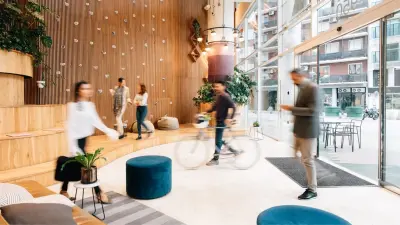How Smart Buildings enhance our wellbeing and promote good health

On average, we spend around 90% of our time inside buildings. These shelter us from the wind and weather, provide space for living and working, and host encounters, culture, and knowledge. In addition to being an integral part of our everyday lives, buildings can make a major contribution to the wellbeing of everyone who spends time in them.
In addition to the steadily increasing levels of comfort delivered by modern technology, buildings can also help keep us healthy. Today many companies support the wellbeing of their employees with healthy food, exercise, and ergonomically designed workplaces. In fact, these offerings have become a major factor for recruiting talent.
Because young people in particular are quite health-conscious, they naturally also want to work in surroundings that are ideal in this respect. Here too, buildings come into play. Their design and furnishings, lighting, thermal comfort, acoustics, and air quality – all this contributes to the wellbeing and productivity of their users. Innovative building concepts can play a major role in modern health management while significantly increasing companies’ attractiveness for employees and occupants.
Which factors inside buildings can impact health?
A Healthy Building is one that evokes a feeling of physical wellbeing in its users. This can be accomplished with the right combination of architecture, design, materials, and technical systems. A wide variety of factors can positively or negatively affect a building’s occupants.

Acoustics
Unwanted and bothersome noise, like that produced by constant traffic or production activities, impairs normal work routines and the ability to concentrate on conversations.
Lighting
Light also influences productivity and performance. Lighting systems that are synchronized with circadian cycles support biorhythms and boost performance as a result.
Air quality
Unless steps are taken to optimize air quality and ventilation, people’s ability to concentrate, among other things, is impaired.
Thermal comfort
Thermal comfort is influenced by the temperature, flow rate, and moisture content of the air. People are most productive at a temperature of 20°C.
Room design
Colors and interior design are crucial for creating a positive, health-enhancing ambiance. Plants and organic shapes also contribute to people’s wellbeing.
These figures speak for themselves
Good-quality air is essential for wellbeing. Excessively dry air, for example, can cause a sore throat or headaches while exacerbating allergies. Studies* have revealed that a healthy, balanced indoor climate ensures better performance while reducing absenteeism caused by illness.
>90% of our time
is spent indoors
Up to 9% loss
of productivity can result from poor indoor air quality
3,600 euros a year
is the cost per person for lack of productivity due to poor indoor climate
About 13,000 liters of air
flow through the nose, mouth, and lungs of every individual every day
66% of all people
become less productive when exposed to constant noise
28% improvement
of working conditions can be brought about by proper lighting
Making buildings healthier with intelligent automation systems
Building Automation systems play a crucial role in ensuring healthy conditions in buildings and rooms. They regulate the indoor climate, ventilation, and lighting and shade, thus meeting the most important prerequisites for users’ wellbeing and health. Without properly functioning automation systems, a building can never be truly healthy.
What can building automation achieve in terms of improving occupants’ health?
Better ability to concentrate: A pleasant indoor temperature harmonized with the season, good relative humidity, and especially fresh air are essential for prolonged concentration. Excessively high CO2 levels in particular can quickly induce fatigue.
Greater wellbeing: A room’s ambiance is determined by its climate and, of course, also its lighting. We long for light that reflects the season of the year and time of day: intelligent lighting improves the working ambiance and makes us feel better.
Improved hygiene: Building automation systems are essential for good hygiene. Systems for heating and distributing hot water can encourage the growth of bacteria that can cause serious symptoms in infected persons; an example is Legionella, which causes Legionnaires’ disease. Mature building automation systems provide effective protection and ensure a hygienic water supply.
Smart adaptation: Intelligent automation strategies also play an important role. Enhanced performance and networking capabilities are now opening up possibilities for designing novel services to support healthy buildings. Smart air quality management, for example, long ago ceased to rely on manual ventilation; now intelligent evaluation of CO2 concentrations, in combination with video and access control systems, enables predictive automatic adjustment of ventilation and air flow depending on the number of persons using a room. Conventional systems don’t increase the air flow until the air quality has already deteriorated.
Room automation – in other words, automation of a structure’s smallest units – has a major impact on the overall building. With the aid of predefined scenarios and smart operating consoles, it’s possible to create a healthier ambiance in every single room.
A worthwhile investment
These days, anyone thinking about modernizing their buildings to conserve resources should keep in mind that modern technologies don’t only reduce costs while boosting the attractiveness of real estate. They also enhance the health and wellbeing of all occupants.
Despite the wide range of facilities available in the real estate market, truly high-quality buildings are hard to find in many areas. Meanwhile, the expectations of companies and their employees are steadily increasing.
Modern work environments with a focus on hygiene, wellbeing, and comfort are in greater demand than ever before.

*Source: Healthy Building Network, HEAL, Condair